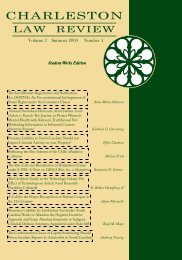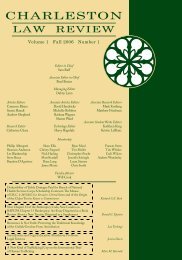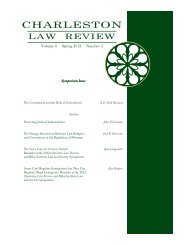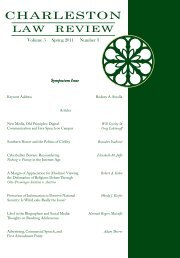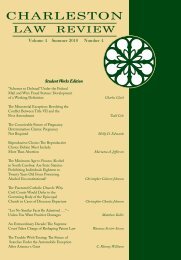Volume 5 Winter 2011 Number 2 - Charleston Law Review
Volume 5 Winter 2011 Number 2 - Charleston Law Review
Volume 5 Winter 2011 Number 2 - Charleston Law Review
Create successful ePaper yourself
Turn your PDF publications into a flip-book with our unique Google optimized e-Paper software.
CHARLESTON LAW REVIEW [<strong>Volume</strong> 5styles present in their classrooms. Moreover, a “teacher must . . .decide which dimension of learner style to consider important.” 133Thus, the question regarding styles is: “What difference do thedifferences make? In other words, which differences amonglearners have consequences for the outcomes of instruction?” 134The consensus of disinterested research is that “matching”teaching style to learning styles is not the panacea thateducators might hope for. Analyses of learning styles studieshave found little to no empirical support for the popular notionthat matching instructional materials to learning styles has apositive pedagogical effect. 135 As one research reviewerconcluded, “[t]he reason researchers roll their eyes at learningstyles is the utter failure to find that assessing children’slearning styles and matching to instructional methods has anyeffect on their learning.” 136Scholarly reviews from the 1970s and 1980s found that“basing instructional adaptations on student preferences does notimprove learning and may be detrimental”; that “cognitivesimilarities between students and teachers affect[] classroominteractions but [do] not influence achievement”; and either weakor non-existent support for the notion of matching modalitypreferences with teaching methods—in fact, some researchpointed to the effectiveness of teaching to the non-preferredmodality. 137 The more recent studies have confirmed thesefindings. 138133. Doyle & Rutherford, supra note 23, at 21.134. Id. at 22.135. In a summary of five research reviews dating to the late 1970sregarding the correlation between modality preferences and learning to read,one author concluded that “[o]ne cannot reliably measure children’s readingstyles and even if one could, matching children to reading programs by learningstyles does not improve their learning.” Stahl, supra note 30, at 2. Regardingthe research basis for one particular theorist’s articles, the author noted thatonly one was published, fifteen were doctoral dissertations, thirteen of whichcame from the theorist’s alma mater, and none of them had been published inpeer-reviewed journals. Id.136. Id. at 1.137. Doyle & Rutherford, supra note 23, at 22 (internal quotations omitted).138. See Coffield, Should We Be Using Learning Styles?, supra note 10, at3940 (reporting on a study that found the number of studies supporting thematching hypothesis was virtually the same as those that did not and noting160



